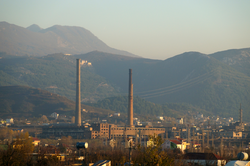Istore
 | This article or section is out of date. A country/countries relevant to this article have been removed from Sahar and have been retconned. Not everything here may still be considered canonical. This article was last edited by Arryog (talk | contribs) 12 months ago. (Update) |
Istore
Vichavian: Istloye | |
|---|---|
 View of Istore | |
| Etymology: Flower of desire | |
| Country | |
| Istore Province | |
| Organized | 1354 |
| Elevation | 1,412 m (4,633 ft) |
| Population | |
| • Total | 858,215 |
| Demonym(s) | Istorian |
Istore (Vanoshan: Istloye /ˈistloye/), also sometimes referred to as Ajane in the Khezian language, is the capitol of Vanosha. The city is found on the confluence of the Sodny and Vasoron rivers, in addition to being commonly referred to as the crossroads of the Transrolovian steppe and Western Vaniu. Nearly 900,000 people live within the administrative districts of Istore, and the most populous of all Vanoshan cities.
Continuously inhabited since the 13th century, it is a young settlement in regards to most capitols of Vaniua. Prior to its settlements, the area was used frequently for its fertile soils by ranchers who took advantage of the plentiful grasses at the confluence. The first original settlement was founded in the 5th century, but it was shortly abandoned following its destruction sometime in the early 7th century. Its original name was lost to time as it was not mentioned in any known records.
The settlement became an important center of trade for goods and livestock exchanged between the Kingdom of Khezan and the duchies of Serbes, Velmarsha, and Svercia. The trade was of such vital importance to the region, and its notability attracted many peoples from the East and West of Vaniua to settle there, bringing with them a diverse culture. This came to an end following the Vintner Revolt of 1744, leading to the refounding of the Duchy of Vanosha that same year.
Later, the city would be the center of the Vanoshan Officers' Coup in 1924, where the AŚPyem successfully ousted the royal government, instituting a one-party totalitarian state which has controlled the country since. Since then, there have been several proposals to rename the city and it has adopted an unofficial nickname as the "Heart of the revolution".
Etymology
The city was named "Flower(s) of desire", referring to the various mountain meadows that surround the area, creating a multi-colored effect throughout spring and summer.
History
The area was formally organized sometime in the 11th century, where Zarasaist clerics established a monastery named Ajane. The monastery was noted for its fortress like design meant to deter the Vanoshan raiders from the north. A small settlement began to form around the monastery until in the 14th century, it was consolidated within the formal boundaries of the monastery and a free city developed with a population of roughly 16,000. The settlement grew prominently and eventually became the seat of the Duchy of Vanosha within the Khezi kingdom to the south. Following the 17th century revolt, the duchy joined the neighboring Vichavian dukedom as and together formed the Kingdom of Vanosha.
Ajane was formally renamed in 1801 as one of its residential areas, Istulev, grew larger and wealthier than the rest of the settlement, following a century of increased migration from the rest of the Vanoshan kingdom. Around the same time, Istulev was made the official sole capital of the kingdom. With much of the economic activity of the country funneling into the city, it became the wealthiest settlement in the entire nation throughout the 19th century, seeing a rail line connecting the city with Khezan and later Lenezan during the mid to later half of the century. The first factories in Vanosha were established in Istulev, resulting in the city being nicknamed the "burning rose" by contemporaries at the time. Its diverse communities, being a frequent stop between Lenezan and Khezan direct lines, and its wealth led to levels of activity that was unheard of in the rest of the nation.
The city was later the center of events in the nation, being the locale where the Officers' coup took place, and later became the capital of the new Union of Vanosha. Throughout the 30s it was noted for the construction of the Śéśvonep, an engineering and research complex, built under the supervision by Chief of the VAI, Svuso Vyerečev. The complex transformed much of the industry as college level education was now available for factory workers in the capital of the nation, whereas before education was limited on a generic basis. Since the 30s, much of the city has transformed to accomodate this complex which has since replaced much of the original monastery grounds, with the old Ajane monastery's relics and artifacts being relocated to a vault in the hills that overlook the city. In 1942, the city was renamed to Istore to match the colloquial pronunciation rather than the historical pronunciation, along with several other cities.
Today, the city enjoys a much significantly higher quality of life from the rest of the country. It is a common tourist attraction as the NAM government attempts to contain tourism to a select few centers. This in turn has led to a restaurant and cafe culture unique to the city despite the near-totalitarian governance of the country, in part due to its favored status as the outward image it desires to share with the world.